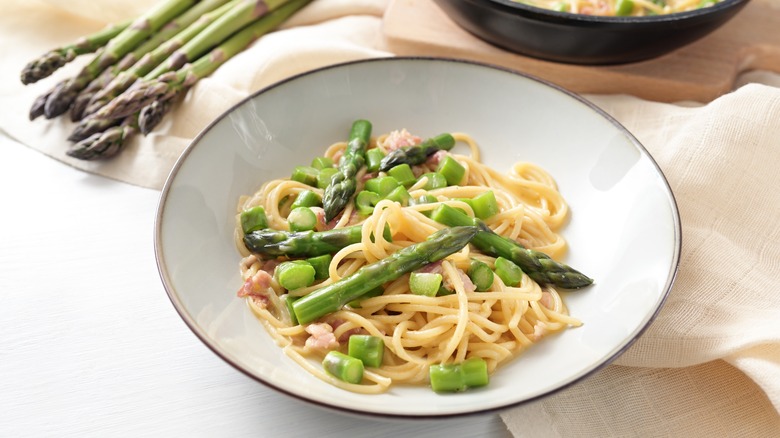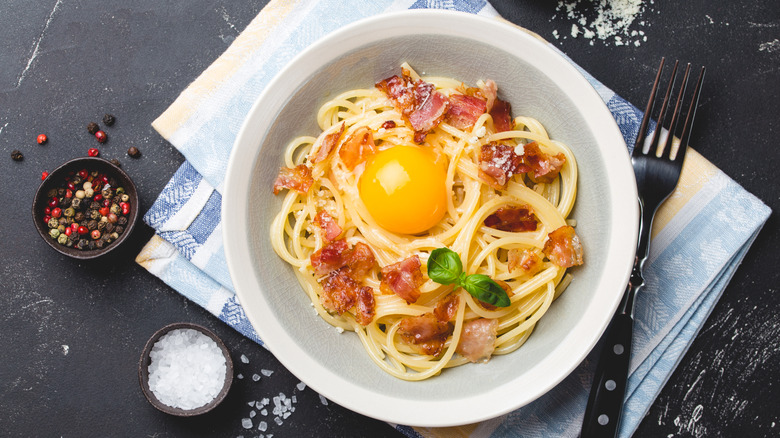Ina Garten's Pro Tip For Deliciously Light Carbonara
We may receive a commission on purchases made from links.
Thanks to the Barefoot Contessa, Ina Garten, there is such a thing as "light carbonara" — two words you don't commonly see together. A classic Roman dish, carbonara is a rich pasta that includes fatty cured pork, eggs, and cheese, making it equally suitable for a satisfying dinner as it is for a filling 2 a.m. snack after a night of imbibing.
Traditionally made with guanciale (salt-cured pork jowl), eggs, black pepper, and lots of Parmesan, Ina Garten has modernized this indulgent pasta recipe to eliminate the need for a nap after a big bowl. The recipe is featured in Garten's 2020 cookbook "Modern Comfort Food," in which she updates other classic recipes like tomato soup. Her approach to carbonara lightens the creamy sauce and adds julienned spring vegetables to make the dish lighter, fresher, and less likely to completely weigh you down.
The spring vegetables are cooked in boiling water along with the pasta, which brings out the veggies' bright green color and saves you from dirtying too many pans. Garten blanches thinly sliced snow peas, shelled fresh peas, and asparagus, then uses the reserved pasta water to make a creamy sauce. Her spring green spaghetti carbonara recipe is finished with lemon zest, fresh chives, and scallions for a delicious yet lighter version of the classic.
Other ways to lighten carbonara
Like another Roman favorite, cacio e pepe, carbonara dish is as much about technique as it is about the right balance of ingredients. Traditionally, Roman-style spaghetti alla carbonara's sauce is made by emulsifying egg yolks with starchy pasta water and doesn't contain cream, but Garten's version uses some heavy cream to bind the sauce together. This makes the recipe more forgiving, and the final dish is somewhat like a cross between Alfredo sauce and carbonara.
While Garten's carbonara recipe incorporates early springtime vegetables, you aren't limited to these veggies alone to lighten the dish. Most any in-season vegetables at any time of year would be a delicious addition to the recipe. To enhance the meatiness of the cured pork, try using a medley of mushrooms. Slice and sauté cremini, shiitake, and/or oyster mushrooms in the rendered fat from the guanciale. Then, toss the umami-rich mushrooms and the sauce with the pasta.
Another option for lightening things up is to replace some of the pasta with zucchini noodles. Spiralize or julienne zucchini and add the "zoodles" to the cooked pasta to heat them up. There's no need to cook the zoodles, as the heat from the pasta will soften them, but they'll still retain a slight crunch.
Additional carbonara variations
To adjust your carbonara to your tastes and the ingredients you can find in your area, pancetta or American-style bacon can be used instead of guanciale without deviating too much from tradition. Bacon adds smokiness to the dish, while pancetta brings a peppery meatiness without stealing the show. Guanciale renders more fat when cooked, so sauces made with it will be thicker, but all three cured pork products make for a delicious final result. Guanciale is also sometimes cured with cloves, black pepper, and cinnamon, so a pinch of these can be added to the finished dish if you miss the warm spices. Whichever pork product you use, freeze the meat for 15 minutes before cutting to make it easier to dice.
For a different way to prepare pasta carbonara, try a deconstructed carbonara made by adding a poached egg to cooked spaghetti and pancetta. The meat is sautéed in butter and tossed with the pasta, then you top individual servings of the dish with an egg. Garnish each bowl with freshly grated cheese (Parmigiano-Reggiano or Pecorino Romano) and black pepper. When broken, the creamy yolk coats the spaghetti to create a luscious sauce that has no risk of turning into scrambled eggs, a common pitfall when cooking classic carbonara. Aside from pasta, carbonara sauce is delicious on risotto or as a pizza topping.



